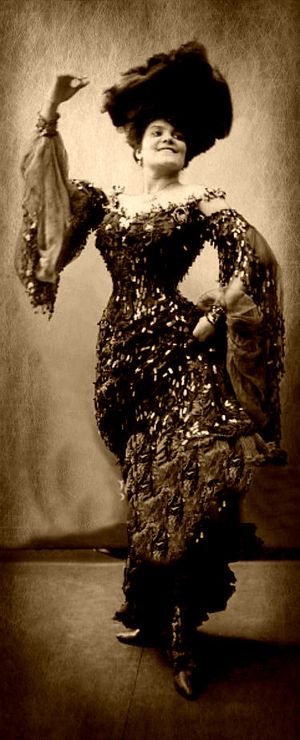Annotation:Dora Dean: Difference between revisions
No edit summary |
No edit summary |
||
| Line 1: | Line 1: | ||
{{TuneAnnotation | {{TuneAnnotation | ||
|f_annotation=[[File:Doradean.jpg|right|300px|thumb|Dora Dean]]'''DORA DEAN'''. American, Country Rag (cut time). F Major ('A' part) & D Minor ('B' part). Standard tuning (fiddle). AA'BB'BB'. This 'raggy' melody was composed by the great African-American entertainer and comedian Bert Williams (1874-1922) and published in 1896 ("Oh have you seen Miss Dora Dean, She's the sweetest gal you ever seen"). Mark Wilson remarks that it was a popular piano piece around the turn of the 20th century; widely popular at the time, it was coined “The Greatest Coon Song Ever Written”. The song was composed in honor of vaudeville entertainer named Dora (Babbage) Dean, an African-American woman who possessed great style, poise and personality, and flaunted in front of white crowds in ways that were unheard of by | |f_annotation=[[File:Doradean.jpg|right|300px|thumb|Dora Dean]]'''DORA DEAN'''. American, Country Rag (cut time). F Major ('A' part) & D Minor ('B' part). Standard tuning (fiddle). AA'BB'BB'. This 'raggy' melody was composed by the great African-American entertainer and comedian Bert Williams (1874-1922) and published in 1896 ("Oh have you seen Miss Dora Dean, She's the sweetest gal you ever seen"). Mark Wilson remarks that it was a popular piano piece around the turn of the 20th century; widely popular at the time, it was coined “The Greatest Coon Song Ever Written”. The song was composed in honor of vaudeville entertainer named Dora (Babbage) Dean, an African-American woman who possessed great style, poise and personality, and flaunted in front of white crowds in ways that were unheard of by a Black performer. Along with her partner and husband, Charles Johnson, she is credited with helping to popularize the Cakewalk dance. Their song-and-dance act took them abroad for months on end, touring Europe and even Australia. They performed in Hungary and Russia, even for England’s King Edward VII. | ||
<blockquote> | <blockquote> | ||
''Say, have you seen Miss Dora Dean?''<br /> | ''Say, have you seen Miss Dora Dean?''<br /> | ||
Revision as of 22:35, 24 March 2023
X:1 T: Dora Dean N:From fiddler Ed Haley (1885-1951, Ashland, northeast Kentucky), from a N:1947 home recording by his son Ralph Haley M:C| L:1/8 R:Country Rag D:Rounder 1131/1132, Ed Haley - "Forked Deer" (1997) D:https://www.slippery-hill.com/content/dora-dean Z:Andrew Kuntz K:F P:A Sfgfc dfcd|fdcA dcAG|A2A2- AGFD|FGFA GFD2| fgfc dfcd|fdcA dcAG-|GAc-d edcA|cdec dcAc| fgfc dfcd|fdcA dcAG|AFED FGA2|+slide+[A4A4]+slide+[A2A2]GF| DCDE FEFG|AGAc dedc|AGFD FGDF-|F3c dcAc|| P:A' fgaf gfdc|df-fc dcAG| +slide+[A2c2][A2c2]- [Ac]AGD|FGAF GFDF| fgfc dfcd|fdcA dcAG-|GAcd edcA|c2c2e2f2| fgff dfcd|fdcA dcAG|AGFD FGA2|+slide+[A4A4]+slide+[A2A2]G2| DCDF- FDFG|AGAc dedc|AGFD FGDD|F3G )[_E3A3]F|| P:B DCDE FDD2| GFGA GFDF|A2 A2- AcAG|A2A,2B,2A,2| DCDE FDD2| GFGA GFDF|1A2 A2- AcAG|A4 A,2 B,C:|2 +slide+[A4A4] [A2A2]GF|D4C4S||

Say, have you seen Miss Dora Dean?
She is the finest gal you’ve ever seen;
I’m a-goin’ try and make this gal my queen,
Next Sunday morning I’m goin’ to marry Miss Dora Dean.
It is, however, a version of "I Don't Love Nobody (1)." Modern fiddle versions are usually sourced to the playing of peripatetic and regionally influential Eastern Kentucky/W.Va. fiddler wikipedia:Ed Haley (1883-1951).

